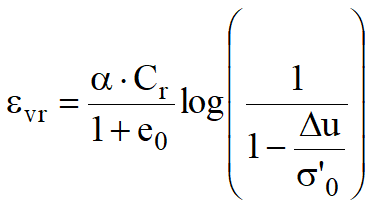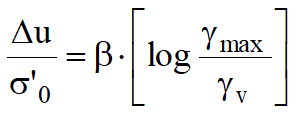The cause of reconsolidation settlements registered after a seismic event in a soil is due to dissipation of the pore water pressure as the water is expelled from the concerned area.To estimate the magnitude of this settlement is necessary to characterize the various soil layers from a geotechnical point of view through in situ and laboratory tests.The number of investigated verticals will be more larger the more important is the work to be carried out and how extensive is the area of investigation. It is necessary to prepare with appropriate surveys the extent of fluctuations in groundwater levels and consider in the analysis the less precaution condition.
For each of the investigated verticals will be assessed the post cyclic reconsolidation settlements. The reconsolidation settlement, for granular saturated liquefiable soils and for cohesive soils, can be calculated using the following expression:
![]()
where H is the height of the generic layer and εvr (%) represents the post-cyclic volumetric strain defined by:

where:
α experimental constant between 1 and 1.5
e0 the initial void ratio
Cr=0.225 Cc the post-cyclic reconsolidation ratio
Cc compression ratio
Note: There are some empirical relations that allow to evaluate, in an approximate way, the compression ratio. In the case of granular soils are functions of the relative density, in the case of cohesive soils are functions of the plasticity index.
In the case of cohesive soils, Loadcap calculates the ratio of pore water pressure as:

where
| σ'v | is the initial value of the effective mean pressure at the considered depth |
![]()
σ'v0 is the effective vertical pressure and k0 the thrust coefficient at rest
γmax is the maximum shearing strain reached during the earthquake
β is taken equal to 0.45 (experimental coefficient)
γv is the volumetric deformation threshold, determined by cyclic laboratory tests
Ma can also be evaluated, in first approximation, with the relationship that follows:
![]()
OCR is the overconsolidation ratio, A and B are the experimental coefficients that can be calculated by linear interpolation from the table below:
IP [%] |
A |
B |
|---|---|---|
20 |
0.4 10-3 |
0.6 10-3 |
40 |
1.2 10-3 |
1.1 10-3 |
55 |
2.5 10-3 |
1.2 10-3 |
Values suggested for the coefficients A and B
The ratio of pore water pressure, in the case of loose liquefiable soils, is determined by linear interpolation from the values reported in table below, depending on the amplitude of the maximum deformation induced by the ground.
γmax [%] |
ru=Δu/σ'0 |
|---|---|
0.005 |
0.2 |
0.1 |
0.4 |
0.2 |
0.6 |
0.4 |
0.8 |
5 |
0.95 |
Pore water pressure ratio ru as a function of γmax
The amplitude of the maximum shearing strain γmax is calculated from the following relationship:

where
amax,s peak acceleration at the ground level of the design earthquake
g acceleration of gravity
| σv | total vertical pressure |
rd reduction factor of the seismic action that puts into account the deformation of the subsoil determined by the
relation rd=1-0.015z;
G shear modulus corresponding to the strain level gmax
The shear modulus can be determined from laboratory tests or using the table below by applying a reduction factor to the shear modulus G0 (shear modulus at low strains).
amax,s [g] |
G/G0 |
|---|---|
0.10 |
0.80 |
0.20 |
0.50 |
0.30 |
0.35 |
0.40 |
0.28 |
Reduction factor of the shear modulus in the first 20 m as a function of the acceleration amax,s
Settlement computation induced by the earthquake in saturated granular soils
The volumetric strain ev in saturated granular soils can be estimated from CPT tests as a function of normalized and corrected tip resistance, (qc1N)cs and of the safety factor to liquefaction FL, and from SPT tests as a function of the normalized and corrected SPT resistance (N1)60,cs and the cyclic stress ratio CSR.
The post-seismic settlement for each layer is given by:
Δsi = εvi*Δzi.
Alternatively, the volumetric strain, εv (expressed in decimals), can be estimated by the following expressions (Idriss and Boulanger, 2008):

where γmax (decimal) is the maximum shear strain induced by the seismic action, determinable, in a first approximation, with the empirical relation:
![]()
where G is the shear modulus of deformation corresponding to the level γ, which can be determined by an iteration process, knowing the value of the initial stiffness G0 (= ρVs2) using the law of variation G(γ)/G0 obtained with dynamic tests in the laboratory or, in an approximate way, deduced from literature curves for soils with similar properties (see eg. Figure 4 from AGI, 2005).
Settlement computation induced by the earthquake in unsaturated granular soils
The settlement induced by the seismic action in unsaturated granular soils can be estimated from the results of SPT tests with the method Pradel (1998), as follows:
Δsi = 2εNC*Δzi where Δs is the settlement of the layer of a thickness Δz
The latter can be determined, in first approximation, with the empirical relation:
![]()
G is the shear modulus corresponding to the deformation level γ, which can be determined by an iteration process, knowing the value of the initial stiffness G0 (= ρVs2), using the variation law G(γ)/G0 obtained by dynamic tests in laboratory.
© GeoStru